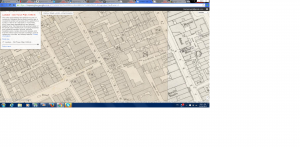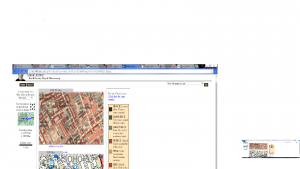 I must apologize in case the screen shot that appeared appeared too small. Wardour street runs through Oxford street in the Soho district of the west end of London. This district is known as the party district, as Chinatown, prostitution clinics, and the vast chains of entertainment and commerce industries are located among this street.
I must apologize in case the screen shot that appeared appeared too small. Wardour street runs through Oxford street in the Soho district of the west end of London. This district is known as the party district, as Chinatown, prostitution clinics, and the vast chains of entertainment and commerce industries are located among this street.
According to the Old Bailey archive, Booth Poverty Map, and the Locating London’s past archives, this residential area is consumed with people who are both rich and poor, however the street itself is not safe and full of danger and violence. There are many accounts and testimonies of theft and grand larceny’s that appeared on the street, most prominently because the street is connected to other streets in the surrounding district; all of which are connected to Oxford street. On the poverty map it shows that on the street itself, that the people are poor or comfortably middle class (purple) and the rest are well-to-do regular middle class (red). With this in mind, it can show that by mixing two classes in the same street can cause conflict based on the differences in culture, attitude amongst each other, and overall availabilities and opportunities that are given to the people.
 Thus as depicted and showed on this map, it is not unreasonable to see that violence and robbery were apparent amongst the people that live on this street. Furthermore, this street is home to sex industries which were very frowned upon by society. From a religious standpoint, those that partake would be scrutinized and condemned to the jurisdiction and harsh consequential acts of the patriarchal system. People that came to the Soho district, and to this street, came to get drunk, laid, or come to be entertained. Thus, many writers and poets/songwriters and other liberal art talents came to get inspiration from this street. However, due to the nature of the party district, many of them did not stay sober long enough, or in cases, survived, in order to publish their works.
Thus as depicted and showed on this map, it is not unreasonable to see that violence and robbery were apparent amongst the people that live on this street. Furthermore, this street is home to sex industries which were very frowned upon by society. From a religious standpoint, those that partake would be scrutinized and condemned to the jurisdiction and harsh consequential acts of the patriarchal system. People that came to the Soho district, and to this street, came to get drunk, laid, or come to be entertained. Thus, many writers and poets/songwriters and other liberal art talents came to get inspiration from this street. However, due to the nature of the party district, many of them did not stay sober long enough, or in cases, survived, in order to publish their works.
Within “Picture of Dorian Gray” by Oscar Wilde, this street comes up in chapter 4 when Dorian is talking with Lord Henry, and Henry tells Dorian that he went to barter and trade an old brocade. Lord Henry then continues to recount how it is difficult to trade things and barter things as people put such a high price on it because of the impoverish settings surrounding the area. e recounts saying the people know the”value of everything and the price of nothing” thus noting that people wish to have as much as they could because they come to this street to thrive and better their lives, but in the end, since nobody knows the price (metaphorically and literally) nobodies situation actually changes. This is the only mention of Wardour street between chapters 1-5, however it plays a significant role as this street is where the “sins” of London ultimately reveal themselves to the readers.

I couldn’t see the picture properly but I could understand thanks to the well written and cear article. http://telkomuniversity.ac.id